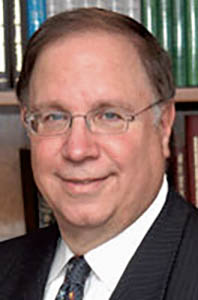
Arab response to the decision by US Senators Marco Rubio (R-FL), Dean Heller (R-NV) and Ted Cruz (R-TX) to introduce The Jerusalem Embassy and Recognition Act, legislation to relocate the U.S. Embassy from Tel Aviv to Jerusalem, has been predictable.
Palestinian Arab Response
Palestinian Authority Mahmoud Abbas claimed the decision would put the Middle East peace process and the whole world into a “crisis.” His close advisor Mahmoud al-Habash called the move “a declaration of war on Muslims.” Ynet noted this description is significant because it echoed a similar sentiment expressed by former Jerusalem Mufti Achrama Sabri, whose extreme views generally do not reflect those of the Palestinian Authority.
Jordanian Information Minister Muhammad Momani said that the transfer would be a “gift to extremists” and would “inflame the Islamic and Arab streets.”
Hussein Ibish, a Senior Resident Scholar at the Arab Gulf States Institute in Washington, D.C., whom Daniel Pipes calls “anti-American, anti-Semitic, inaccurate and immoral,” went even further when he warned of a “spontaneous, or possibly even organized, [violent] uprising is extremely plausible—perhaps even inevitable, if not immediately.”
As if on cue, US Secretary of State John Kerry added his caveat, which could easily be interpreted as a justification for an aggressive Arab response: “You’d have an explosion, an absolute explosion in the region, not just in the West Bank and perhaps even in Israel itself, but throughout the region.”
Relocation of Embassy Unsettles Palestinian Arab Campaign to Deny Jewish Claim to Jerusalem
Relocating the US embassy to Jerusalem poses a more serious problem for the Palestinian Arabs than disrupting a non-existent peace process. As part of a political strategy to delegitimize Israel, they initiated a campaign to obliterate 3,000 years of Jewish history in Israel and replace it with their own fabricated history, with the intention of creating the past history of a Palestinian Arab nation and state. The process involves appropriating Jewish traditions, tenets and historical narrative, allowing them to portray the Jews as interlopers, colonialists and usurpers of Arab lands.
The Palestinian Media Watch reported that this plot was first conveyed at a conference of Palestinian Arab historians in 1998. Dr. Yussuf Alzamili, Chairman of the History Department, Khan Yunis Educational College, urged all universities and colleges “to write the history of Palestine and to guard it, and not to enable the [foreign] implants and enemies to distort it or to legitimize the existence of Jews on this land… [History lecturer Abu Amar] clarified that there is no connection between the ancient generation of Jews and the new generation.”
To bolster Palestinian Arab claims, PA government media, flags, maps, cartoons, youth movement logos, schoolbooks and schools and children’s educational programs use maps removing Israel, signifying Palestinian Arab political sovereignty throughout all of Israel. The Holocaust and other areas of Jewish history are either denied, minimized or falsified. Christianity is also targeted. Jesus is falsely and improbably described as a Palestinian Arab who preached Islam (despite the centuries gap between the emergence of Christianity and the subsequent appearance of Mohammed), thereby not only repudiating Jewish history, but also the history and legitimacy of Christianity.
The PA accuses Israel of fashioning a false Jewish history in the land while appropriating Palestinian history, culture and heritage. The Palestinians refer to these actions as “Judaization.” The main target of this “Judaization” is the Al-Aqsa Mosque, which Israel allegedly schemes to demolish in order to build the Jewish Temple. At the same time, PA political and religious leaders, officials and academics refer to the Temple as Al-Haikal Al-Maz’oom, the “alleged Temple.”
Erasing Any Trace of Archeological Evidence of Jewish and Christian History Is a Key Element in This Process
Erasing any trace of archeological evidence of Jewish and Christian history is an essential part of this campaign, asserted columnist David M. Weinberg. Synagogues and Jewish holy sites in Jericho, Nablus and Gush Katif were burnt down as Palestinian Arab police watched. Palestinian Arab mobs in 1996 attacked Rachel’s Tomb in Bethlehem while Palestinian Arab policemen wounded the Israeli soldiers protecting the Tomb. Since then the Israelis were forced to enclose the site with concrete barriers, turning it into a veritable fortress. A Palestinian Arab horde led by Palestinian Arab policemen raided Joseph’s Tomb in Nablus, torched the inside of the synagogue and killed six of the Israeli soldiers guarding the site.
The Temple Mount had a section known as the Holy of Holies, where the Ark of the Covenant, containing the Ten Commandments and the Torah resided, explained Mark Ami-El, editor of The Jerusalem Center for Public Affairs Daily Alert. Jews were obligated to visit Jerusalem three times a year. After the Babylonians destroyed the First Temple in 586 BCE, Jews returned to Jerusalem from exile in 538 BCE and finished building the Second Temple in 515 BCE. Even after the Temple’s destruction by Roman armies in 70 CE, Jews directed their prayers to the Temple Mount.
To justify their claim that the Temple Mount is the site of a mosque dating back to the time of Adam and Eve, they are transforming the area into holy places, mosques and Muslim holy sites and removing everything to substantiate Israeli claims to the area. Thousands of tons of material have been dumped in the Kidron Valley and the city garbage dump at Eizariya, while they build underground mosques at the site.
Included in these ruins were the archeological remains—masonry stones, blocks, floor tiles and pottery—from the period of the First and Second Temples. Decorations and inscriptions on stones were removed, as were Hebrew lettering and five-pointed stars, a Hasmonean symbol found on handle seals from the second century BCE. The Wakf also destroyed stonework produced by Jewish artisans 2,000 years ago in the underground “double passageway.”
Similar to the well-reported Taliban and ISIS destruction of historical sites, less well known is that Christian relics on the Temple Mount were also demolished, including the Crusader pillars of the 13th-century Grammar Dome in the southwestern corner of the Mount, and the Crusader-era Chain Gate. Without any concern for the integrity of the these historic objects, the Waqf has permitted drilling holes in them, spray painting them and chopping through them for electricity cables, and allowed concrete and stone to be added to them.
Demolition of Artifacts: An Act of Resistance
Barnard College anthropologist Nadia Abu El Haj, representing the view of many Palestinian Arabs, defends destroying archaeological artifacts and sites: “Looting could well be analyzed as a form of resistance to the Israeli state and an archaeological project, understood by many Palestinians, to stand at the very heart of Zionist historical claims to the land.” She argues that Israeli archeologists use their craft to substantiate Jewish national homeland in a land where Jews never lived. In the process, the Israelis have “erased other geographies. Most centrally, it effaced Arab/Palestinian claims to and presences within the very same place.”
Responding to These Fabrications
The problem with these incessant barrage of lies is that they are repeated not just in the Palestinian Arab media, but in statements of human rights organizations, academic books and journals and at the UN.
Jewish religious, spiritual and historical attachment to Jerusalem and the land of Israel has never wavered, as Reuben Gafni, a legal expert on historical rights and one of the early members of the Mizrachi and Hapoel Hamizrachi Movement, stressed. The Jewish nation, he said, has never abandoned or surrendered its right to return to their ancestral home or claimed any other country or territory as their new homeland.
The need to explain the Jewish link to Jerusalem and the land of Israel is not new. In his testimony before the Anglo-American Committee of Inquiry on Palestine in 1946, David Ben-Gurion, Israel’s first prime minister, explained to the British and American committee members that more than 3,000 years before the Mayflower departed England for the New World, Jews fled from Egypt. And “every in the Jew in the world knows exactly when we left. It was the 15th of Nisan.”
Each spring, Jews commemorate their liberation from slavery and the Exodus from Egypt to the land of Israel at the Seder, which traditionally ends with the sentence: “Next year in the Jerusalem!” Some add the word rebuilt: “Next year in the rebuilt Jerusalem.”
Religious rituals were instituted to remember the destruction of the Temples in Jerusalem and the subsequent exile. During times of joy and sorrow, Zion is always part of a Jew’s thoughts and liturgy. At least three times a day, observant Jews pray for the redemption of Zion and Jerusalem and for her well-being. When comforting a Jew on the loss of a loved one, we say, “May God comfort you (amongst) the other mourners of Zion and Jerusalem.”
Throughout Jewish history, Jews have recited Psalm 137: “If I forget thee, O Jerusalem, let my right hand forget her cunning. Let my tongue cleave to the roof of my mouth, if I do not remember you if I do not set Jerusalem above my highest Joys.” The verse is sung at the end of Jewish weddings.
The words of Jeremiah (33:10-11), form a prayer sung at weddings to ask God to rebuild the Temple in Jerusalem and restore joy and happiness to the streets of Jerusalem: “Yet again there shall be heard… in the cities of Judah, and in the streets of Jerusalem. The voice of joy and the voice of gladness, the voice of the bridegroom and the voice of the bride.”
Israel’s national anthem, written in 1886 by Naphtali Herz Imber, makes this eternal connection point quite clear: “As long as the Jewish spirit is yearning deep in the heart, With eyes turned toward the East, looking toward Zion, Then our hope—the two-thousand-year-old hope—will not be lost: To be a free people in our land, The land of Zion and Jerusalem.”
By moving the US embassy to Jerusalem, political scientist Miriam F. Elman suggests, “Sending a strong message that the new administration stands with the Israeli government on a major symbolic issue with high potential costs could push the Palestinian leadership to a greater sense of urgency in negotiations.” Moreover, given the failures of decades of diplomacy that deliberately fell sway to the same arguments being advanced today against moving the American Embassy to the capital of Israel, as the President-elect stated while campaigning for African-American votes, “What have you got to lose?”
By Alex Grobman, PhD
Alex Grobman, a Hebrew University-trained historian, is a consultant to the America-Israel Friendship League, a member of the Council of Scholars for Scholars for Peace in the Middle East (SPME) and a member of the Advisory Board of The Endowment for Middle East Truth (EMET).












